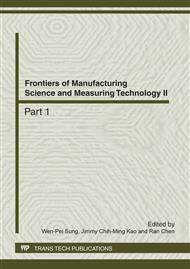p.896
p.900
p.905
p.909
p.913
p.918
p.923
p.927
p.931
Kinematic Forward Solution Analysis of the 3-PRS Parallel Robot
Abstract:
It is always hot and difficult to research kinematic forward solutions of the Parallel robots .In the paper according to the trait of 3-PRS parallel robot, the three freedom degrees are analyzed by using helix theory, which include one prismatic freedom degree along z axis and two rotation freedom degrees along and axis. The movement equation of the motion platform center is given on this basis, then the example is programmed by making use of Matlab software, in the end the kinematic forward solutions are gained. The method is in common use and is suitable for other type parallel robots. This also provides the reference value for control strategy
Info:
Periodical:
Pages:
913-917
Citation:
Online since:
April 2012
Authors:
Price:
Сopyright:
© 2012 Trans Tech Publications Ltd. All Rights Reserved
Share:
Citation:


